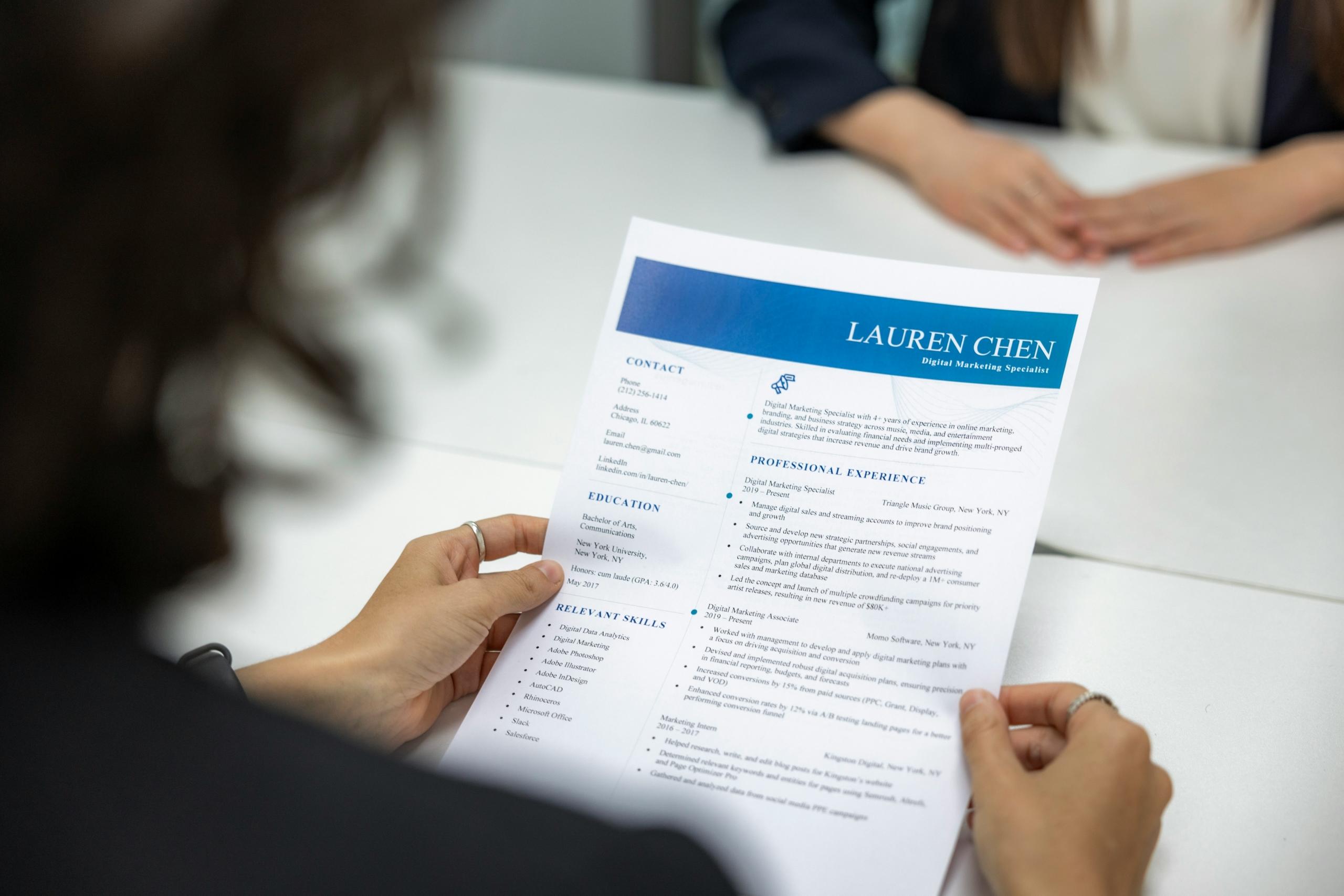If you have applied for a job either here in Ireland or overseas over the past few years, then you will likely be all too familiar with how competitive the job market has become.
The days of getting a job based on the merit of an undergraduate degree are long behind us. Even if you have a master's degree or years of experience, you can expect to have a tough time securing employment.
Since the job market for graduate roles up to the senior level has never been so competitive, there is all the more reason to craft the perfect CV. It’s up to you to catch the eye of potential employers and convey that you are the best candidate for the job.
In this article, I aim to provide you with an actionable blueprint for crafting the perfect CV so that you can more easily secure interviews in the future.


What to Include in Your Curriculum Vitae
In order to provide you with a blueprint for crafting the perfect resume, I will introduce the sections that you will need to include in order to effectively communicate your suitability for the role. I will then go on to elaborate on the most significant sections that will play the biggest role on landing you that dream job!
Bullet points help the reader to gain a quick view of ‘you’ to date. (Also see ‘hard to read’, below.) Don’t use solely bullet points, though: introduce each set with a sentence or two about what they relate to. Don’t elaborate too much, but express yourself in succinct, convincing short sentences and paragraphs.
• Professional Summary. A short section on where you are in your life, who you are and what you seek. Don’t boast and be specific.
• Personal information. Include your name and principal contact details on every page, either in the header or footer. Include the ‘page X of X’ facility, which Word and similar programs allow you to do quite simply.
Later on in the document (after your educational and information about positions you’ve held) elaborate on the personal information: see ‘more about you’, below.
• Education. Ensure you include your education to date: what schools/colleges you attended, what you studied and what your grades were. If you have not finished your current one, include it without the grade.
If you are young and your Curriculum Vitae is in its early stages of development (see ‘the long and short of it’, below) you have an opportunity to expand. Why did you choose your subjects? Have you gained any particular accolades to date? Why did you win the class prize for your GSCE Graphic Art project?
If you are more mature, keep your education to the facts: schools; dates; exam successes and grades; any notable achievements and awards.
• Experience: No matter what stage of life you are in, put any paid positions you have held on your CV. If you are still at school but you have had a paper round, include it. If you are later in life and have had multiple positions, include only the more relevant ones.
The level of detail you include will depend upon how many positions you have held. Include the dates, employer name and address, your job title/s, key responsibilities and any particular achievements.
If you are really looking to make a memorable application and separate your CV from the rest of the pile, then constructing a post-interview thank you can go a long way towards making a good impression on your potential employers.
Structuring and Formatting
Before you start filling out whatever Curriculum Vitae template you may have picked out, you should consider a number of considerations.
There is no set list of boxes that you will need to tick if you are crafting a checklist for the perfect resume. This is because different kinds of jobs require different resume formats.
If you were applying for a job in graphic design, then your resume should also serve as a portfolio for your work. You can count on your potential employer paying close attention to the design aspect of your resume.
Creative designs include features like columns, patterns, and vibrant visuals, which are ideal for fields or industries that prioritise innovation. Contemporary designs find a balance between imaginative approaches, often showcasing two columns with a modern and polished look.
On the other hand, If you were applying for a job as an investment banker, you would want to tailor the format to be more text-heavy, conveying any experience you might have from similar roles.
This traditional layout is typically your best bet across most industries. It features a simple column design with standard fonts and minimal use of colour or graphics. It focuses on your suitability for the role and allows you to describe your education and experience in greater detail.

Craft an Engaging Summary or Objective
When writing a standout resume for any role that you might be interested in, it’s important to constantly put yourself in the shoes of the interviewer and ask yourself what they would think if they sat down and went through your application.
Keep in mind that in today’s jobs market, there could be upwards of a few hundred other applications for the role that you are going for. This means that you will need to capture their interest from the outset. Since the professional summary is going to be the first section that they read, this is a great place to try to stand out.
The last thing an employer wants to see is a generalised resume that looks like it has been sent out to thousands of companies. If you want to make it to the top of the pile, make sure to customise this section based on the job you're applying for by reviewing the job description and identifying its requirements.
Your professional summary should emphasise your accomplishments, skills, and expertise to match the role you're targeting. Whenever possible, quantify your achievements to show their impact and credibility.
The main goal in this section is going to be to clearly outline your career objectives and how they align with what the company is looking for. So, avoid making any generalised statements, instead focus on highlighting how your unique skills and career aspirations make you an excellent fit for the position.

Highlight Work Experience and Accomplishments
Perhaps the most important section of your resume that will really capture the interest of your potential employer is the experience and accomplishments section. This is your opportunity to convey that you are capable of performing in the advertised role.
When crafting this section, you can start by detailing your previous roles and mentioning the company name, location, job title, and employment dates.
Remember that you goal is to secure an interview for the role with your Curriculum Vitae, so you will have the opportunity to elaborate on your experience at a later date. So describe each position briefly but persuasively outlining your responsibilities and standout accomplishments.
It’s also even more impressive if you have some tangible metrics that you can provide to quantify any of the achievements that you mention and provide proof of your contributions. For example of saying "Increased sales " you might say "Led a marketing initiative that boosted sales by 25% in just six months."
It’s all about using your resume to present yourself as the ideal candidate. So, if you have limited experience, consider including internships, volunteer work or extracurricular activities to showcase your skills and dedication.
Once you hear back from a potential employer and receive a job offer for the position you applied for, you can begin crafting your resignation letter to hand to your current company.
Showcase Relevant Skills and Certifications
Perhaps the biggest tip I can give you when crafting your resume with a specific role in mind is to visit the job descriptor for the advertised position and make sure that your resume reflects the core competencies that they have outlined.
Many major companies have an automated Curriculum Vitae screening process since they receive a large volume of applications. These systems often eliminate the resumes of applicants that don’t contain the respective keywords or core skills outlined in the job listing.
A great way to ensure that you don't fall through the cracks of these filtering systems is to include a personalised CV cover letter that communicates your interest in working with the company.
Make sure to have a section dedicated to showcasing both your abilities and soft skills using bullet points or a skills matrix. Also, you don't want to forget to mention any certifications or professional courses you've completed, as they show your dedication to learning and expertise in different areas.
Before sending out your application, carefully review the job listing to pinpoint the criteria and preferred qualifications. Then strategically showcase the parts of your background that directly relate to those requirements. This might involve rearranging or rewording sections of your CV to ensure that the pertinent information stands out.
This section should include details like the certification title, awarding organisation, and completion date. Keep in mind the platforms or software that you might need to use in the advertised role and demonstrate your proficiency for the respective roles. If you're working towards a certification, you can also mention the expected completion date.
This is also a section that you can elaborate on in text through the personalised cover letter that you craft!

How an Employer Will Likely Navigate your CV
When you apply for a job, the way your Curriculum Vitae is constructed can significantly influence how a potential employer navigates through it. Crafting the perfect Curriculum Vitae requires a blend of creative and structured writing.
Start with a strong personal statement that succinctly outlines your career objectives and what makes you stand out. This is often the first section an employer will read, so make it compelling.
Your academic history, including your time at university, should be detailed next. Here, emphasise any art-related courses or projects that showcase your creative skills and dedication to your craft. Including images or a link to your personal website can provide a visual supplement that highlights your abilities beyond written content.
Experience, particularly recent jobs or internships, should be outlined in a way that demonstrates your growth and achievements in practical settings. Use action verbs to describe your responsibilities and accomplishments, making sure to include any roles that required creativity, leadership, or teamwork.
Employers also value extracurricular activities or volunteer work that shows you're a well-rounded student or professional. These can create a more personal image of you and illustrate your interests and values.
Craft the Perfect CV With the Help of Superprof
Now that you have a step-by-step guide on what to include when crafting your Curriculum Vitae with a specific role in mind, you are sure to impress. However, if you still find yourself wondering what experience to include and what to commit from your application, then you could get some value from working with a tutor from Superprof.
Many of the tutors listed on the platform specialise in helping candidates just like yourself craft the perfect resume to showcase their suitability for a role of interest. Engaging a Superprof instructor to perfect your resume could be a game changer for anyone seeking a job.
Individualised attention guarantees that your Curriculum Vitae meets standards and showcases your distinct abilities and background compellingly. Superprof tutors, backed by reviews and diverse knowledge, offer tailored support to help you shine in the job market.
Not to mention, they will also be able to leave you with plenty of First job tips and prepare you for the different kinds of Phone interview questions.
Whether you need assistance polishing your CV, refining your cover letter, or preparing for interviews, a Superprof instructor can offer guidance aligned with your career objectives. The option of in-person sessions allows you to enhance your application materials at your pace and convenience, significantly boosting your prospects of securing the job you desire.
Not all interviews are conducted in person, especially when the employer has a high volume of applicants to get through. By working with a private tutor, you can also work on zoom call and phone interview preparation to ensure that you are ready for all the interviews you land with your new CV!











